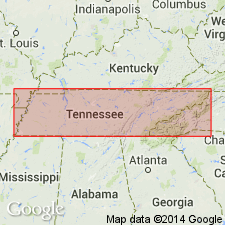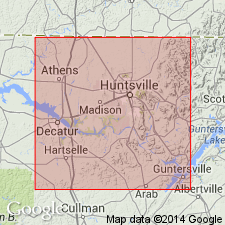
- Usage in publication:
-
- Eden shales
- Modifications:
-
- Named
- Dominant lithology:
-
- Shale
- Limestone
- AAPG geologic province:
-
- Cincinnati arch
Summary:
Named the Eden shales in southwestern OH, southern IN, and central northern KY for Eden Park, Cincinnati, OH. Unit also called middle shales of Cincinnati beds proper. Consists of slightly fossiliferous blue shale with small amount of interbedded limestone. Thickness is 250 feet. Overlies River Quarry beds and underlies Hill Quarry beds, all included in the Cincinnati beds proper. The Eden is of Late Ordovician age. [The Eden was later adopted as a group to include Fulton shale at base and Latonia shale at top]
Source: GNU records (USGS DDS-6; Reston GNULEX).

- Usage in publication:
-
- Eden group
- Modifications:
-
- Revised
- AAPG geologic province:
-
- Cincinnati arch
Summary:
Pg. 2 (fig. 1), 175-179. Eden group. Geographically extended into central Tennessee. An intercalation of beds carrying an Eden fauna and lithologically different from Leipers and Catheys occurs low on southeastern flank of Nashville dome. This zone is here named Inman formation. [Age is Late Ordovician.]
Source: US geologic names lexicon (USGS Bull. 1200, p. 1213).

- Usage in publication:
-
- Eden
- Modifications:
-
- Not used
- AAPG geologic province:
-
- Cincinnati arch
Summary:
Eden Group not used in southern OH and northern KY to avoid confusion with Edenian stage. These rocks are called Kope Formation.
Source: GNU records (USGS DDS-6; Reston GNULEX).

- Usage in publication:
-
- Eden Group
- Modifications:
-
- Areal extent
- AAPG geologic province:
-
- Appalachian basin
Summary:
The Eden Group is represented in the AL subsurface by the Inman Formation. Consists of green and red shale and limestone, green dolomite, and gray limestone.
Source: GNU records (USGS DDS-6; Reston GNULEX).
- Usage in publication:
-
- Eden
- Modifications:
-
- Overview
- AAPG geologic province:
-
- Appalachian basin
GNU Staff, 1994, GNU Staff remark.: U.S. Geological Survey Digital Data Series, DDS-6, 1 CD-ROM., release 3
Summary:
The use of the term Eden as a lithostratigraphic unit should be avoided to avert confusion with the Edenian Stage of the Cincinnatian Provincial Series.
Source: GNU records (USGS DDS-6; Reston GNULEX).
For more information, please contact Nancy Stamm, Geologic Names Committee Secretary.
Asterisk (*) indicates published by U.S. Geological Survey authors.
"No current usage" (†) implies that a name has been abandoned or has fallen into disuse. Former usage and, if known, replacement name given in parentheses ( ).
Slash (/) indicates name conflicts with nomenclatural guidelines (CSN, 1933; ACSN, 1961, 1970; NACSN, 1983, 2005, 2021). May be explained within brackets ([ ]).

